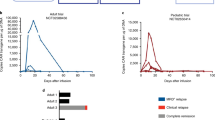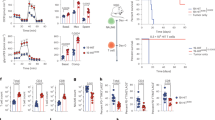Abstract
T cells bearing chimeric antigen receptors (CARs) are broadly categorised into first- and second-generation receptors. Second-generation CARs contain a co-stimulatory signalling molecule and have been shown to secrete IL-2, undergo greater proliferation and to have enhanced persistence in vivo. However, we have shown that T cells bearing a first-generation CAR containing a CD19-targeting scFv (single-chain variable fragment) and the CD3ζ-signalling domain are able to produce IL-2 upon co-culture with CD19+ B-cell lymphomas independent of CD28 activity. Here, we report that signalling through endogenous CD2 following ligation with its ligands, CD48 in mouse and CD58 in humans, drives IL-2 production by first-generation CD19-specific CAR. Moreover, the high levels of IL-2 produced by human T cells engrafted with a second-generation CD28-containing CAR during target-cell recognition are dependent to a degree upon CD2 receptor activity. These observations highlight the fact that the functional activity induced by T-cell-expressed CARs is dependent upon endogenous ‘natural’ receptor interactions. A deeper understanding of the role of these activities will serve to further refine the design of future CARs to either exploit or avoid these interactions.
This is a preview of subscription content, access via your institution
Access options
Subscribe to this journal
Receive 12 print issues and online access
$259.00 per year
only $21.58 per issue
Buy this article
- Purchase on Springer Link
- Instant access to full article PDF
Prices may be subject to local taxes which are calculated during checkout



Similar content being viewed by others
References
Morgan RA, Dudley ME, Rosenberg SA . Adoptive cell therapy: genetic modification to redirect effector cell specificity. Cancer J 2010; 16: 336–341.
Park JH, Brentjens RJ . Adoptive immunotherapy for B-cell malignancies with autologous chimeric antigen receptor modified tumor targeted T cells. Discov Med 2010; 9: 277–288.
Bridgeman JS, Hawkins RE, Hombach AA, Abken H, Gilham DE . Building better chimeric antigen receptors for adoptive T cell therapy. Curr Gene Ther 2010; 10: 77–90.
Hombach A, Sent D, Schneider C, Heuser C, Koch D, Pohl C et al. T-cell activation by recombinant receptors: CD28 costimulation is required for interleukin 2 secretion and receptor-mediated T-cell proliferation but does not affect receptor-mediated target cell lysis. Cancer Res 2001; 61: 1976–1982.
Sadelain M, Brentjens R, Riviere I . The promise and potential pitfalls of chimeric antigen receptors. Curr Opin Immunol 2009; 21: 215–223.
Cheadle EJ, Hawkins RE, Batha H, Rothwell DG, Ashton G, Gilham DE . Eradication of established B-cell lymphoma by CD19-specific murine T cells is dependent on host lymphopenic environment and can be mediated by CD4+ and CD8+ T cells. J Immunother 2009; 32: 207–218.
Musgrave BL, Watson CL, Haeryfar SM, Barnes CA, Hoskin DW . CD2-CD48 interactions promote interleukin-2 and interferon-gamma synthesis by stabilizing cytokine mRNA. Cell Immunol 2004; 229: 1–12.
Ventura A, Meissner A, Dillon CP, McManus M, Sharp PA, Van Parijs L et al. Cre-lox-regulated conditional RNA interference from transgenes. Proc Natl Acad Sci USA 2004; 101: 10380–10385.
Krause A, Guo HF, Latouche JB, Tan C, Cheung NK, Sadelain M . Antigen-dependent CD28 signaling selectively enhances survival and proliferation in genetically modified activated human primary T lymphocytes. J Exp Med 1998; 188: 619–626.
Maher J, Brentjens RJ, Gunset G, Rivière I, Sadelain M . Human T-lymphocyte cytotoxicity and proliferation directed by a single chimeric TCRzeta /CD28 receptor. Nat Biotechnol 2002; 20: 70–75.
Kato K, Koyanagi M, Okada H, Takanashi T, Wong YW, Williams AF et al. CD48 is a counter-receptor for mouse CD2 and is involved in T cell activation. J Exp Med 1992; 176: 1241–1249.
Brentjens RJ, Santos E, Nikhamin Y, Yeh R, Matsushita M, La Perle K et al. Genetically targeted T cells eradicate systemic acute lymphoblastic leukemia xenografts. Clin Cancer Res 2007; 13: 5426–5435.
Krensky AM, Sanchez-Madrid F, Robbins E, Nagy JA, Springer TA, Burakoff SJ . The functional significance, distribution, and structure of LFA-1, LFA-2, and LFA-3: cell surface antigens associated with CTL-target interactions. J Immunol 1983; 131: 611–616.
Jacob MC, Agrawal S, Chaperot L, Giroux C, Gressin R, Le Marc'Hadour F et al. Quantification of cellular adhesion molecules on malignant B cells from non-Hodgkin's lymphoma. Leukemia 1999; 13: 1428–1433.
Lee RV, Braylan RC, Rimsza LM . CD58 expression decreases as nonmalignant B cells mature in bone marrow and is frequently overexpressed in adult and pediatric precursor B-cell acute lymphoblastic leukemia. Am J Clin Pathol 2005; 123: 119–124.
Diederichsen AC, Stenholm AC, Kronborg O, Fenger C, Jensenius JC, Zeuthen J et al. Flow cytometric investigation of immune-response-related surface molecules on human colorectal cancers. Int J Cancer 1998; 79: 283–287.
Koretz K, Schlag P, Moller P . Sporadic loss of leucocyte-function-associated antigen-3 (LFA-3) in colorectal carcinomas. Virchows Arch A Pathol Anat Histopathol 1991; 419: 389–394.
Mayer B, Lorenz C, Babic R, Jauch KW, Schildberg FW, Funke I et al. Expression of leukocyte cell adhesion molecules on gastric carcinomas: possible involvement of LFA-3 expression in the development of distant metastases. Int J Cancer 1995; 64: 415–423.
Kochenderfer JN, Yu Z, Frasheri D, Restifo NP, Rosenberg SA . Adoptive transfer of syngeneic T cells transduced with a chimeric antigen receptor that recognizes murine CD19 can eradicate lymphoma and normal B cells. Blood 2010; 116: 3875–3886.
Bridgeman JS, Hawkins RE, Bagley S, Blaylock M, Holland M, Gilham DE . The optimal antigen response of chimeric antigen receptors harboring the CD3zeta transmembrane domain is dependent upon incorporation of the receptor into the endogenous TCR/CD3 complex. J Immunol 2010; 184: 6938–6949.
Naldini L, Blömer U, Gallay P, Ory D, Mulligan R, Gage FH et al. In vivo gene delivery and stable transduction of nondividing cells by a lentiviral vector. Science 1996; 272: 263–267.
Zufferey R, Nagy D, Mandel RJ, Naldini L, Trono D . Multiply attenuated lentiviral vector achieves efficient gene delivery in vivo. Nat Biotechnol 1997; 15: 871–875.
Markowitz D, Goff S, Bank A . A safe packaging line for gene transfer: separating viral genes on two different plasmids. J Virol 1988; 62: 1120–1124.
Cheadle EJ, Hawkins RE, Batha H, O'Neill AL, Dovedi SJ, Gilham DE . Natural expression of the CD19 antigen impacts the long-term engraftment but not antitumor activity of CD19-specific engineered T cells. J Immunol 2010; 184: 1885–1896.
Cheadle EJ, Gilham DE, Hawkins RE . The combination of cyclophosphamide and human T cells genetically engineered to target CD19 can eradicate established B-cell lymphoma. Br J Haematol 2008; 142: 65–68.
Jacks T . The pSico and pSicoR Information Page. Massachusetts Institute of Technology, http://web.mit.edu/jacks-lab/protocols/pSico.html.
Gilham DE, O’Neil A, Hughes C, Guest RD, Kirillova N, Lehane M et al. Primary polyclonal human T lymphocytes targeted to carcino-embryonic antigens and neural cell adhesion molecule tumor antigens by CD3zeta-based chimeric immune receptors. J Immunother 2002; 25: 139–151.
Acknowledgements
We thank Professor Doug Fearon for providing the 1D3 hybridoma, and Dr Taylor Jacks and Dr Tim Sommerville for the pSicoR vectors. We would also like to thank the service units at the Paterson Institute for Cancer Research, in particular, the staff in the Molecular Biology Core Facility and the flow cytometry service. We also thank the Kay Kendall Leukaemia Fund, Cancer Research UK and the FP6 programme ‘ATTACK’ for funding this work. EJC was funded by the Kay Kendall Leukaemia Fund. DGR, JSB, REH and DEG were funded by Cancer Research UK.
Author information
Authors and Affiliations
Corresponding author
Ethics declarations
Competing interests
The authors declare no conflict of interest.
Rights and permissions
About this article
Cite this article
Cheadle, E., Rothwell, D., Bridgeman, J. et al. Ligation of the CD2 co-stimulatory receptor enhances IL-2 production from first-generation chimeric antigen receptor T cells. Gene Ther 19, 1114–1120 (2012). https://doi.org/10.1038/gt.2011.192
Received:
Revised:
Accepted:
Published:
Issue Date:
DOI: https://doi.org/10.1038/gt.2011.192
Keywords
This article is cited by
-
Cluster of differentiation antigens: essential roles in the identification of teleost fish T lymphocytes
Marine Life Science & Technology (2022)
-
Are chimeric antigen receptor T cells (CAR-T cells) the future in immunotherapy for autoimmune diseases?
Inflammation Research (2021)
-
Induced Pluripotent Stem Cells (iPSCs) Provide a Potentially Unlimited T Cell Source for CAR-T Cell Development and Off-the-Shelf Products
Pharmaceutical Research (2021)
-
Chimeric Antigen Receptor T cells for B Cell Neoplasms: Choose the Right CAR for You
Current Hematologic Malignancy Reports (2016)
-
Gene-engineered T cells for cancer therapy
Nature Reviews Cancer (2013)



